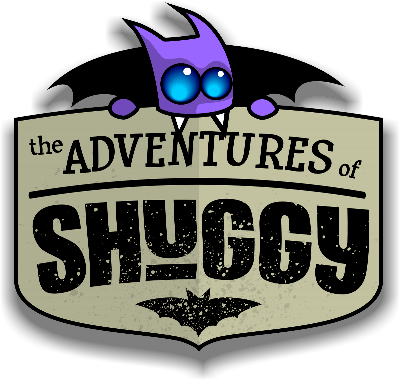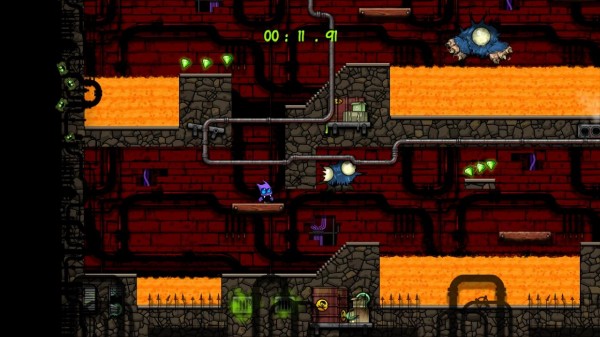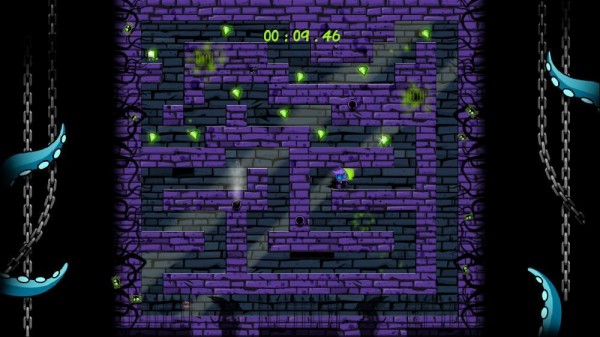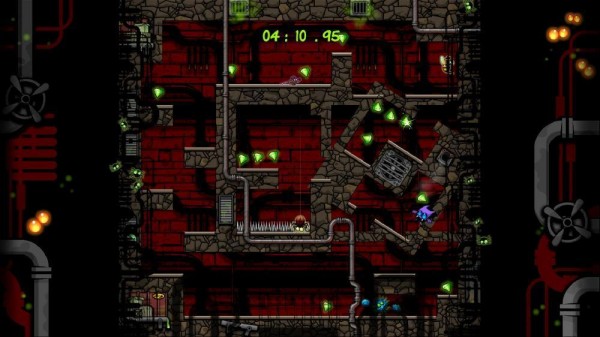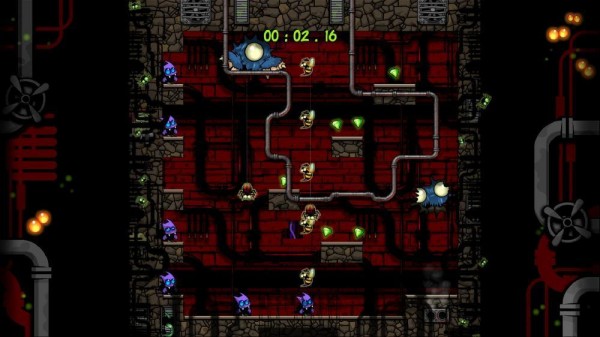Q & A with Smudged Cat Games
The Adventures of Shuggy is an overlooked diamond in the rough. There will always be those games that we love that have sales to match. Shuggy, however has had a bit of a sluggish start. But this isn’t one of those games to simply toss aside, it’s one that should hang out on your radar. Below you’ll find a Q & A session sent to us from Smudged Cat themselves detailing who they are and how Shuggy game to be.
Who are you? Tell us a bit about yourself.
My name is David Johnston, I’m based in the UK and I set up Smudged Cat Games about 4 years ago in order to develop Shuggy. I’ve always been interested in video games and have worked on various projects in my spare time over the years. I’ve only worked at one games company and have mainly spent my working life being a software engineer for various different companies.
What did you do in the games industry before Smudged Cat?
I’ve always been working on some gaming project in my spare time. From about the age of 8 I started messing around with coding on my BBC micro. A game I wrote appeared in one of those magazines where they actually print the code so readers can type it in when I was 11. I worked on various little games for the BBC and Acorn Archimedes when I was at school, some actually got published. I made a game called Ground Hog for the Archimedes which was published in 1998 and was the first time I made a game featuring time travel where the player kept looping around the same period of time to encounter earlier versions of himself. I developed the idea further for a game called Timeslip which I developed on the PlayStation Yaroze. It appeared on the cover disk of an Official UK PlayStation Magazine.
After studying Computing Science at Glasgow University I worked at Rare for a while (before MS took over) mainly developing tools rather than actual games. After that I decided the games industry wasn’t really for me, *grins*, and returned to Glasgow to work for a company developing document viewing software for mobile devices. I worked on a game called Knight Time for the PC in my spare time based around time travel but didn’t really have the time to give it the polish it deserved. I moved to a company down in Cambridge but still needed to scratch my gaming itch and started developing Shuggy in my spare time.
Who is Shuggy?
Shuggy is a vampire, although not the scary dark brooding type. I like to think that he’s turned his back on the whole drinking blood thing and would be quite a nice to person to know. If there’s a sequel we’ll find out more about Shuggy’s back story.
What does the name mean?
It’s a very Scottish name that I think is short for Hugh, although I wasn’t aware of that when I first picked the name. I think I first heard the name watching an episode of Rab C. Nesbitt or something equally Scottish. I actually made a completely unrelated game for the Acorn Archimedes a while ago called Shuggy. I don’t think anyone would remember the game but I liked the name so I thought I’d re-use it. Apparently a Shuggy is also a type of swing but it doesn’t seem to be used very often.
Given you could have written anything – why did you choose to write Shuggy?
My main passion is for platform games. The fact I started writing the game in my spare time limited my options, I knew I didn’t have the time or resources to write a sprawling 3D action game or a MMORPG. The original idea for Shuggy was to make a platform version of a Warioware game. The intention was to make every single level unique and last about 20-30 seconds. As it developed it became clear that some of the ideas were certainly worthy of a few levels and the levels that required more time to solve were more interesting than the really short ones. A lot of the original level mechanics were dropped as they didn’t really work and I focused more on the interesting ones such as rotating the levels, time travel and the rope swinging.
Do you do all the work by yourself?
I did all the coding and designed the levels. My artistic skills are on a par with a goldfish so for Shuggy I worked with Chris Hildenbrand at Imbri Design, based in Australia. He is responsible for the artwork in the game. I worked with Pompom for some of the Xbox specific elements and the LIVE support. A friend of mine, Bennet Aldous, at Fat Cat Comics did the comic book cut-scenes and Jesse Hopkins composed the music.
How did you find working remotely with the rest of the team?
It’s certainly a different way of working than having everyone in the same office. It would have been helpful to have people closer together on a few occasions but in general it worked fairly well. With me responsible for the coding and the level design I pulled all the bits together. I came up with the game so it wasn’t as though I was wrestling with anyone for creative control. I was happy for Chris to take complete control of the artistic direction so he was free to design the characters and environments however he saw fit. It’s strange to think that we’ve made this great game but I’ve only ever met Chris once.
Where did you get the idea of a cuddly purple vampire from?
Chris Hildenbrand at Imbri Design came up with the actual character so I’ll let him answer that one:
‘To be honest it was more or less by accident. Take a few simple vector shapes and twist them around and somehow you will end up with a purple, blue eyed vampire with pointy shoes – well that is if you are a crazy artist with way too much exposure to the sun and German beer.’
How did Shuggy come to be?
I started writing the game when Microsoft released the XNA framework, the fact anyone could write a game and run it on their Xbox 360 really appealed to me. When Microsoft announced the Dream.Build.Play competition in 2007 and someone could win an XBLA publishing contract I put all my effort into getting the game ready for the deadline and submitted it with my fingers crossed. When Shuggy made the top 20 I went to Seattle for the Gamefest conference where the winner would be announced. Unfortunately it didn’t get one of the four publishing deals that were awarded that year but I made a few contacts that led to my own publishing deal with Sierra Online.
Unfortunately, when Activision/Blizzard acquired Vivendi Games (the owner of Sierra Online) they decided to terminate the Shuggy contract. After a long period of not knowing what was going to happen with the project it was picked up again by Valcon Games and we finally got the game finished and ready for release.
Why did you choose to write it for XBLA?
The decision was mainly driven by the XNA framework. I started writing the game in my spare time so I couldn’t afford to invest in a professional development kit for one of the main consoles. With XNA you can just download the framework and immediately start working on a Windows game without it costing you anything. To run the game on an Xbox you do need a subscription but once I’d developed the Windows version a reasonable amount I knew I wanted to make an Xbox version. XNA is platform independent so it probably only took a day or two to get it running on the Xbox.
What’s the best thing about XBLA?
XBLA is a really good service compared to its rivals. The fact you can download a trial version of every game really helps but probably the best thing about releasing an XBLA game is the achievements. Everyone loves to bag the achievements from a new game and it really appeals to players when buying a new game.
What’s your favourite XBLA game?
That’s tricky, there are so many good XBLA games. I’ve spent many hours playing Trials HD and even designed a couple of my own tracks but probably my all time favourite game is N+. It’s just such a pure platforming challenge and the controls are absolutely perfect. There aren’t that many different enemies and objects in the game but the levels are so well designed that I can keep playing the game forever. It’s the only XBLA game I’ve bagged all the achievements on. I loved Limbo but I nearly snapped a 360 pad in two attempting to get the “No Point in Dying” achievement (Completing the game in one sitting with five or fewer deaths).
What’s unique about Shuggy?
I think the variety of different gaming mechanics is what makes Shuggy really unique. Other games focus on just one mechanic such as rotating the level or time travel but the variety spread throughout Shuggy means you never know what’s coming up and keeps the game fresh right to the very end. I’m also really happy with the way you progress through the game. I’ve tried my best to ensure that there are always a few levels to chose from and different routes to each of the boss encounters. I hate playing a game and getting really stuck on one level so you can’t progress any further.
The different game mechanics also mean that the difficulty curve is as close to a flat line as you’re likely to get. I find some games get so difficult in later stages that I sit staring at the screen after dying for the 100th time thinking “I remember when the landscape was a bright lush green instead of dark and constantly crumbling into lava and I could actually enjoy playing this game instead of getting constantly frustrated”. The challenge in Shuggy comes from playing with new mechanics rather filling the screen with more danger.
What’s your favourite level in Shuggy?
It’s probably a level called “Maze of Switches”. You control three Shuggys and there are a bunch of switches that open doors. The reason I like it is that it’s the only level that I’ve played a few times and couldn’t figure out how it’s completed. I’ve sat there doing yet another playthrough of the game to test it thinking “this is ridiculous, how do you get those gems on the right again?”
What other games is it a bit like?
Although it’s drifted from the original idea a bit I think it does share a bit with the Warioware series. The levels don’t take long to play and there is a lot of variety. I hope it shares some of the platform “feel” of the 2D Mario games and N+. The time mechanics are similar to what featured in Braid and my own Timeslip game which is available on Indie games.
What are your gaming influences?
My main influence has to be the original Mario series on the NES and SNES. It’s what I grew up playing and I still have fond memories of. The controls from those games still stand the test of time today and are great games to play. Some iPhone games are big influences to me now as I have more time to play those than the bigger Xbox and PS3 games. I would say Cut the Rope and Tiny Wings are brilliant examples of game design and show that you don’t need a massive budget to produce an awesome game.
What other games has Smudged Cat produced?
I have three games on Xbox LIVE Indie Games, A Bomb’s Way, The Tower: A Bomb’s Climb and Timeslip. A Bomb’s Way and The Tower: A Bomb’s Climb were originally going to be mini-games in Shuggy but were removed and reskinned to make separate games. They’re all priced at a ridiculously low 80 points!
A Bomb’s Way is a bit like an old game called BombJack but you can rotate the level. You play as a bomb with a fuse that’s ticking down who will explode at any minute. Each level you have to collect clocks to extend the length of your fuse but at any given time one of the clocks will be ringing. Collecting the ringing clocks gets you more points and is the key to achieving a high score.
The Tower: A Bomb’s Climb features the same bomb from A Bomb’s Way but this time he’s climbing a tower which is slowly being engulfed by flames. The game is controlled by a single button which powers up a jump sending him flying through the air when you release the button. The basics are quite simple but timing your jumps can become quite tricky as things speed up. You can play also play local and online multiplayer which is where the game really shines, flying up the tower to leave your friend in the flames is always entertaining.
Timeslip is a game that I originally made for the PlayStation Yaroze and was on an Official UK PlayStation Magazine cover disk. It’s been given a graphical makeover since then but the levels are still exactly the same. I was a lot meaner back then, those levels are hard! It follows the same pattern as the timeslip levels in Shuggy. The player continually travels back in time to encounter earlier versions of himself which must be avoided but are the key to keeping doors open and progressing.
What are the differences between Indie Games and XBLA?
Releasing a game for XBLA is much more difficult but gains a lot more visibility. Releasing an Indie Game is a matter of finishing the game and putting it up for review on the App Hub. Other App Hub members will then download the game and test it to make sure everything works OK. If enough people review your game and don’t find any problems then the game gets published to XBLIG. Microsoft have much tougher checks in place for releasing an XBLA game which can take a while to get right. Standing out as an XBLIG can be tough though, there are a lot of sub-par games on the service which hide the gems.

